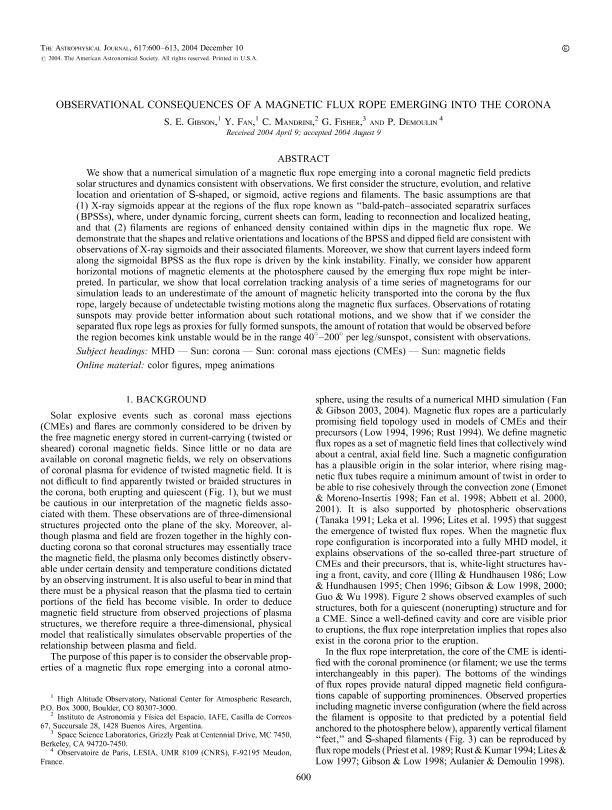Mostrar el registro sencillo del ítem
dc.contributor.author
Gibson, S. E.
dc.contributor.author
Fan, Y.
dc.contributor.author
Mandrini, Cristina Hemilse

dc.contributor.author
Fisher, G.
dc.contributor.author
Démoulin, Pascal

dc.date.available
2017-07-24T17:59:40Z
dc.date.issued
2004-12
dc.identifier.citation
Gibson, S. E.; Fan, Y.; Mandrini, Cristina Hemilse; Fisher, G.; Démoulin, Pascal; Observational consequences of a magnetic flux rope emerging into the corona; IOP Publishing; Astrophysical Journal; 617; 1; 12-2004; 600-613
dc.identifier.issn
0004-637X
dc.identifier.uri
http://hdl.handle.net/11336/21173
dc.description.abstract
We show that a numerical simulation of a magnetic flux rope emerging into a coronal magnetic field predicts solar structures and dynamics consistent with observations. We first consider the structure, evolution, and relative location and orientation of S-shaped, or sigmoid, active regions and filaments. The basic assumptions are that (1) X-ray sigmoids appear at the regions of the flux rope known as ``bald-patch-associated separatrix surfaces (BPSSs), where, under dynamic forcing, current sheets can form, leading to reconnection and localized heating, and that (2) filaments are regions of enhanced density contained within dips in the magnetic flux rope. We demonstrate that the shapes and relative orientations and locations of the BPSS and dipped field are consistent with observations of X-ray sigmoids and their associated filaments. Moreover, we show that current layers indeed form along the sigmoidal BPSS as the flux rope is driven by the kink instability. Finally, we consider how apparent horizontal motions of magnetic elements at the photosphere caused by the emerging flux rope might be interpreted. In particular, we show that local correlation tracking analysis of a time series of magnetograms for our simulation leads to an underestimate of the amount of magnetic helicity transported into the corona by the flux rope, largely because of undetectable twisting motions along the magnetic flux surfaces. Observations of rotating sunspots may provide better information about such rotational motions, and we show that if we consider the separated flux rope legs as proxies for fully formed sunspots, the amount of rotation that would be observed before the region becomes kink unstable would be in the range 40°-200° per leg/sunspot, consistent with observations.
dc.format
application/pdf
dc.language.iso
eng
dc.publisher
IOP Publishing

dc.rights
info:eu-repo/semantics/openAccess
dc.rights.uri
https://creativecommons.org/licenses/by-nc-sa/2.5/ar/
dc.subject.classification
Astronomía

dc.subject.classification
Ciencias Físicas

dc.subject.classification
CIENCIAS NATURALES Y EXACTAS

dc.title
Observational consequences of a magnetic flux rope emerging into the corona
dc.type
info:eu-repo/semantics/article
dc.type
info:ar-repo/semantics/artículo
dc.type
info:eu-repo/semantics/publishedVersion
dc.date.updated
2017-07-24T14:12:30Z
dc.journal.volume
617
dc.journal.number
1
dc.journal.pagination
600-613
dc.journal.pais
Reino Unido

dc.journal.ciudad
Londres
dc.description.fil
Fil: Gibson, S. E.. National Center for Atmospheric Research; Estados Unidos
dc.description.fil
Fil: Fan, Y.. National Center for Atmospheric Research; Estados Unidos
dc.description.fil
Fil: Mandrini, Cristina Hemilse. Consejo Nacional de Investigaciónes Científicas y Técnicas. Oficina de Coordinación Administrativa Ciudad Universitaria. Instituto de Astronomía y Física del Espacio. - Universidad de Buenos Aires. Facultad de Ciencias Exactas y Naturales. Instituto de Astronomía y Física del Espacio; Argentina
dc.description.fil
Fil: Fisher, G.. Space Science Laboratories; Estados Unidos
dc.description.fil
Fil: Démoulin, Pascal. Centre National de la Recherche Scientifique. Observatoire de Paris; Francia
dc.journal.title
Astrophysical Journal

dc.relation.alternativeid
info:eu-repo/semantics/altIdentifier/url/http://iopscience.iop.org/article/10.1086/425294/meta
dc.relation.alternativeid
info:eu-repo/semantics/altIdentifier/doi/http://dx.doi.org/10.1086/425294
Archivos asociados
